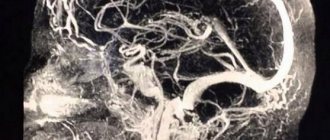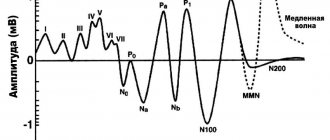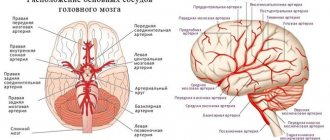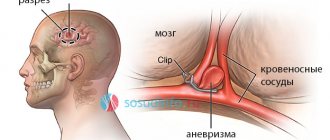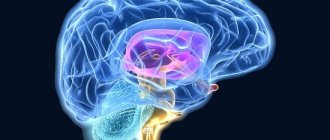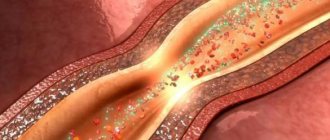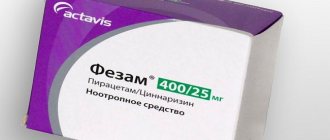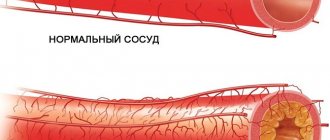Raeography of the head (REG)
Posted at 23:55h in Services by doctor
Rheoencephalography of cerebral vessels is a simple but effective diagnostic method. As a result of this procedure, pathological processes such as circulatory disorders, as well as other deviations from the normal functioning of this important organ, are identified.
The method is popular with patients and doctors. This is explained not so much by the affordability of the survey, but by its high information content and the ability to quickly obtain accurate results.
A big advantage over other methods of examining cerebral vessels is its minimal invasiveness, which becomes a factor favoring the use of this diagnostic even for pediatric patients.
Features of the event
REG is performed using a rheographic attachment and a recording device. The child sits comfortably. The doctor applies a special gel to his head and places electrodes on rubber bands. The location of the application is determined by the assigned tasks. During the examination, you may need to perform simple commands: turn, tilt your head. Functional tests provide the most accurate data.
The indicators are recorded by a computer, and the results are displayed graphically on a special tape, similar to an ECG.
The procedure takes no more than half an hour and does not cause discomfort or pain to the little patient. Parents are allowed to be near the child, since it is necessary to maintain a motionless body position.
General information about the method
Rheoencephalography (REG) allows you to identify circulatory disorders in the brain even in the early stages of pathology and thereby prevent the possibility of developing complications that pose a danger to the health and life of patients.
Its invaluable advantage over MRI and CT is the ability to be examined without waiting in line, which in other places takes about six months. Without detracting from the effectiveness of magnetic resonance and computed tomography, it should be noted that timely treatment is the key to victory over the disease, and in some cases, the ability to save the patient’s life.
What kind of procedure is this, who needs it, how to prepare for the examination - these are the questions that will be discussed in the article.
For what purpose is it carried out?
In addition to procedures related to the need to study pathological changes in the arteries and vessels of the brain, it is advisable to conduct REG for preventive purposes.
Decoding
When analyzing the rheogram, the data obtained as a result of the examination, as well as age, health status and chronic diseases are taken into account. The graph that appears on the screen or paper tape when examining a teenager will be different from the graph of an adult. In the first one, it looks like a series of uneven waves with clearly defined periodic peaks. In an adult, it looks like a straight line with evenly spaced vertices. The graph shows anacrotes, catacrotes and incisuras.
Anacrota is a wave that shoots sharply upward with a slightly rounded top. Catacrota is a wave that goes down smoothly. An incisura is a notch between a downward wave and a tooth that anticipates the next wave.
Decryption is carried out only by a specialist. During the analysis, the regularity and type of waves, features of the rounding of the top, the dicrotic tooth located after the descent of the wave, and the position of the notch are assessed. Based on the results of the analysis, the doctor determines the signs of pathologies:
- With the hypotonic type, the waves have sharp, high peaks, the tooth or additional waves are displaced, the incisura and amplitude are increased.
- The hypertensive type is characterized by prolonged anacrosis with displaced waves, additional waves are possible. The amplitude is reduced and uneven. The teeth have different shapes.
- Cerebral atherosclerosis is indicated by flat tops, soft vibrations, and the absence of additional waves on the catacrota. In severe pathology, the waves have a dome shape.
- Spasm of the walls is characterized by round peaks.
- With stagnation of venous blood and difficulties in its outflow, increased catacrota and a large number of small waves between the main ones are observed.
- Angiodystonia is manifested by floating teeth and waves on the catacrota.
Only a functional diagnostics doctor is involved in decoding.
A rheoencephalogram is a graphic representation of vibrations corresponding to a certain blood supply to the brain.
The rheogram distinguishes the main elements:
- Anacrota is the ascending part of the wave. Displays blood flow to the organ being examined. The steeper the rise, the higher the tone and less elasticity of the arteries.
- Top of the wave. Corresponds to the period of time during which blood inflow is equal to outflow. Changes with disturbances in the venous bed.
- Catacrota is the downward part of the wave. Displays the condition of veins and arteries, after incisura - only veins.
- Incisura, also known as cutting, is a short-term flattening of the curve before the rise. The moment corresponds to the transition from systole to diastole. Characterizes the elasticity of blood vessels.
- Diastolic wave is a wave following an incisura, with a smaller amplitude than an anacrotic wave. Shows total vascular resistance.
Previously, the encephalogram was deciphered using tables that show all the values of the components of the graph. Now these calculations are carried out by a special computer program.
When analyzing the obtained REG data, the patient’s age must be taken into account, because the parameters for determining the norm for each age are different.
In conclusion, the doctor does not indicate the probable diagnosis, but the type of blood flow disorder:
- Normotonic – adequate vascular resistance and normal venous outflow.
- Dystonic – constant vasodilation, stagnation of venous blood.
- Angiodystonic – low elasticity of blood vessels associated with pathology of the walls of arteries and veins.
- Hypertensive – persistent increase in peripheral vascular resistance. Violation of venous circulation. Characteristic is the lack of rhythm in the appearance of waves. Most often it indicates the presence of sclerotic changes in the vessel wall.
It should be understood that determining the presence of disorders is not even half of the diagnosis. This is only a determination of the functional state of the vascular bed, and to make a full diagnosis, additional, more informative diagnostic methods are required (ECG, ultrasound of the neck vessels, ECHO of the heart, ultrasound, CT or MRI of the brain). But it is possible to suspect the presence of diseases with a high degree of probability.
Characteristic signs of some of the most common variants of pathological conditions in neurology that are visible on a rheoencephalogram:
- Migraine – higher waves on one side.
- Vegetovascular dystonia (VSD) – the top of the wave is rounded, low amplitude.
- Hypertension - the diastolic wave becomes more pronounced and closer to the top. The amplitude of the waves decreases.
- Atherosclerosis - the apex is smoothed out, the waves gradually take on the shape of an arch, and the amplitude decreases.
- Liqueur hypertension - disappearance of incisura, the curve is expressed in the shape of a dome.
Operating principle of the device
The essence of rheoencephalography is that with the help of a special device - a rheograph - an electric current of low frequency is passed through the brain, as a result of which the resistance of brain tissue is visualized on the monitor. In this way, disorders in arteries, veins and small vessels are detected .
The presence of six channels in the device makes it possible to simultaneously examine several areas of the brain.
In the projection of the studied areas, metal electrodes are installed using an elastic rubber band, which transmit the image to the monitor.
The essence and principle of the study
What is REG? If we decipher the abbreviation and translate it into Greek, it turns out that rheoencephalography is “reo” - “flow”, “encephalo” - “brain”, “graphia” - “I write, I depict”. All together forms a record of the blood supply to the brain. For such an examination of the head, a weak electric high-frequency current is used, the passage of which changes the value of tissue resistance.
Blood, like almost all liquids, is an electrolyte, and when blood vessels are filled with it, electrical resistance values decrease. The obtained values are recorded on a tape by a specially designed device (rheograph), which results in a curve called an encephalogram. Afterwards, based on the data, the rate of change in resistance is assessed, which indicates the rate of blood flow, vessel filling and other indicators.
When is an REG prescribed?
- patient complaints of dizziness;
- deterioration of condition with changes in atmospheric pressure;
- osteochondrosis;
- noise in ears;
- debilitating headaches;
- suspicion of ischemic disease;
- memory losses;
- weakened vision;
- hearing loss;
- atherosclerosis;
- hypertensive crisis;
- dystonia;
- hypertension of the cerebral arteries.
For all pathologies associated with a violation of the condition of blood vessels - their blood supply, changes in blood flow speed and viscosity, it is necessary to conduct an REG.
REG examination of cerebral vessels. Part 1. Lecture for doctors
Lecture for doctors “REG examination of cerebral vessels.” Part 1
Content
Ultrasound or REG. Aspects of the use of rheoencephalography to assess cerebral circulation. Part 2
Analysis of rheographic (REG) curve. Part 3
Methodology for rheoencephalography (REG). Study of cerebral blood flow. Part 4
Changes in REG in arterial hypertension. Part 5
Vascular dystonia. REG examination of cerebral vessels. Part 6
Changes in REG in atherosclerosis. REG examination of cerebral vessels. Part 7
Changes in the venous blood supply to the brain and intracranial hypertension. REG examination of cerebral vessels. Part 8
Intracranial hypertension. REG examination of cerebral vessels. Part 9
Cerebral circulation disorders. REG examination of cerebral vessels. Part 10
Changes in REG in case of impaired patency of the cerebral arteries. REG examination of cerebral vessels. Part 11
Closed craniocerebral injury. REG examination of cerebral vessels. Part 12
Functional tests in REG. REG examination of cerebral vessels. Part 13
Artifacts during registration of rheograms. REG examination of cerebral vessels. Part 14
Pathologies. REG examination of cerebral vessels. Part 15
Rheographic methods (REG)
Rheographic methods have virtually no contraindications and are suitable for long-term studies, including monitoring. The method allows long-term observation of patients while studying the effects of various pharmacological agents and assessing compensatory capabilities. The use of multichannel rheographs (polyreography) allows one to study the redistribution of blood and simultaneously assess the state of blood circulation in various organs under the influence of treatment and under functional loads.
This is a bloodless method for assessing the dynamic characteristics of blood circulation, based on graphical recording of changes in the electrical resistance of living tissues during the passage of high-frequency alternating current through them and reflecting changes in the pulse blood supply of the studied area of the body during the cardiac cycle, the functional state of blood vessels, and their tone.
Features of blood circulation in the brain
The blood circulation of the brain is characterized by specific features due to its complex structural and functional organization. The volume of blood flowing through the human brain usually accounts for a significant portion (in adults, approximately 15%) of the total blood volume. Of the total amount of oxygen entering the body with inhaled air, the brain consumes 20 - 25%.
In addition to the mass of circulating blood, an important factor determining the intensity of blood supply to the brain is the speed of blood flow. It is known that the speed of arterial blood flow in the brain is much higher than in other organs. This intensive blood supply is provided by a large and complex network of cerebral vessels with diverse angioarchitecture.
The blood supply to the brain is carried out by two pairs of main arteries - the internal carotid and vertebral, forming a circle of Willis at the base of the brain. The circle of Willis is a powerful collector that distributes blood in the brain. Due to the equality of pressure in the right and left, as well as in the anterior and posterior halves of the circle of Willis, “dead points” are formed in certain places of the anterior and posterior communicating arteries, in which there is no blood movement.
Consequently, blood from different vessels within the circle of Willis does not mix under physiological conditions, but enters the vascularization zone of each individual artery.
The posterior cerebral circulation is supported by blood flow from the vertebral arteries, and after their fusion into the basilar artery, blood from the right vertebral artery flows strictly along the right half, and from the left vertebral artery - along its left half. Perhaps the uniform distribution of blood along the homolateral sides is also facilitated by the vascular bundles extending from the dorsal sides of the vertebral arteries at their confluence.
However, even with a slight decrease in pressure in any of the main vessels (pressure of the arteries in the neck during sudden movements of the head or compression of the neck), blood immediately flows in the direction of the decreased pressure. From the above it is clear that the dynamics of blood supply to the brain, even under physiological conditions, depends on the state of collateral circulation. The circle of Willis is the most powerful and constantly operating system of anastomoses, providing collateral circulation in both hemispheres. In addition, there are two more systems of anastomotic connections that do not function under normal conditions, but become important in conditions of vascular pathology. These are the connections of the internal carotid and vertebral arteries with the external carotid artery and the anastomoses of the three cerebral arteries to each other on the surface of the brain.
The total mass of intracranial contents (medullary matter, arterial blood, venous blood and cerebrospinal fluid) is relatively constant. Arterial blood flow is an important factor in maintaining intracranial pressure. A change in the blood supply to the brain affects the pressure of the cerebrospinal fluid. Hemodynamics in the brain is maintained by the pulse movements of the blood. Rhythmic fluctuations in the volume of cerebral vessels (brain pulsation) are associated with active constriction and dilation of blood vessels and the movement of cerebrospinal fluid, and also depend on a number of influences, in particular on contractions of the heart and breathing (the suction action of the chest, promoting venous outflow from the brain).
The outflow of blood from the cranial cavity is carried out through a developed venous system (veins, sinuses, venous outlets), openly communicating with the extracranial veins. The anatomical and functional unity of the cerebral veins with the extracranial veins and the absence of valves in them provide the possibility of blood flow in different directions - depending on local conditions and the needs of the tissues for the inflow and outflow of blood. Using these features of the venous circulation of the head, A.A. Kedrov and A.I. Naumenko (1954), while studying the cerebral hemodynamics of dogs, obtained experimental data confirming the pulse nature of blood movement in the vessels of the brain in a closed skull. Constant pulse and respiratory fluctuations of intracranial pressure in a closed skull, according to their data, are possible due to the presence of peculiar adaptive mechanisms: on the one hand, the existence of a pulse venous outflow from the cranial cavity and, on the other, due to the movement of cerebrospinal fluid from the cranial cavity into the spinal cavity in connection with different phases of breathing. This was later confirmed in the studies of Yu.E. Moskalenko and A.I. Naumenko (1957). They determined not only the nature of these oscillations (pulse waves, respiratory waves and third-order waves), but also their absolute values. In the closed cavity of the skull, the volume of the brain fluctuates slightly due to the fact that it is surrounded on all sides by incompressible cerebrospinal fluid and during pulse fluctuations the blood pressure encounters counterpressure on all sides.
Cerebral hemodynamics, therefore, differs from the blood supply to other organs not only in its greater intensity and constancy, but also in the characteristics of collateral circulation, as well as its close relationship with cerebrospinal fluid circulation. The latter is manifested in the great interdependence between venous and liquor pressure. With venous stagnation of the brain, liquor hypertension develops.
Along with the existence of a relationship between the circulation of blood and cerebrospinal fluid, there is a close interdependence between the state of regional blood flow and the functional activity of various brain formations. Increased blood circulation in some structural formations of the brain during their increased activity is accompanied by a decrease in blood supply to others, which are at this time in a state of relative rest.
Due to the rich intracranial collateral blood flow - both arterial and venous - there is no area in both hemispheres that is supplied exclusively by one main artery or one main vein. This, along with the redistribution of blood in the brain depending on the functional activity of its various formations, determines the advisability of studying the regional hemodynamics of the brain simultaneously in several of its areas.
Mechanisms of rheoencephalogram (REG) formation
Changes in impedance between electrodes applied to the scalp are determined by a complex set of factors, which are presented in Fig. 1.1.
The leading factors, or disturbing influences, are fluctuations in systemic venous and arterial pressure, and the rest play a modulating role. The latter should be divided into three groups. The first is the factors of intracranial hemodynamics that determine the information content of the rheoencephalogram (REG). The second group includes factors not related to intracranial hemodynamics, i.e. factors that are a source of interference and reduce the information value of the REG. Therefore, it is necessary to find out the conditions under which the influence of intracranial factors will be most pronounced, and the influence of interfering factors will be minimal.
Based on the diagram in Fig. 1.1 it is obvious that intracranial hemodynamic and liquorodynamic factors can have a pronounced modulating effect on REG. Indeed, pulse changes in the passive electrical properties of intracranial contents are determined by an increase in blood supply to the cranial cavity due to pulse fluctuations in the arterial and venous systems of the brain. Due to the peculiarity of the biophysical structure of the intracranial hemodynamic system, the ability of the brain vessels to accommodate an additional volume of blood compared to other organs is very limited. In the mechanisms of compensation of systolic blood volume, factors such as fluctuations in intracranial pressure, acceleration of blood flow, transmission of arterial pulsation to the veins directly through the cerebrospinal fluid, redistribution of intracranial volume between arterial, venous blood and cerebrospinal fluid are of particular importance. The electrical conductivity of the cerebrospinal fluid differs from the electrical conductivity of the blood, and the latter is not the same in different parts of the vascular system of the brain. Thus, the REG pulse wave is a complex biophysical signal of a complex nature, the main information value of which lies in the ability to judge pulse changes in the blood supply to the brain tissue, which in turn depends on the extensibility of the walls of cerebral vessels. Consequently, REG can reflect both structural changes in the walls of cerebral vessels, for example in atherosclerosis, and dynamic changes in their tone in response to functional loads. The latter may be of interest as a non-invasive methodological approach for assessing the adaptive abilities of the vascular system of the brain under certain external influences on the body or pathological conditions.
Rice. 1.1. Scheme of REG wave formation
Influence of extracranial hemodynamic factors. The question of the relationship between extra- and intracranial factors is the most controversial in the physiological and biophysical justification of the REG method. As follows from Fig. 1, extracranial vessels are influenced by the same hemodynamic factors as intracranial ones. Moreover, their reactions to such influences as changes in the partial pressure of carbon dioxide in arterial blood, fluctuations in blood pressure, sympathetic stimulation and some other influences may be unequal and even multidirectional. The study of the relative role of extra- and intracranial vessels in the genesis of REH is carried out through biophysical analysis and through experimental physiological research.
Biophysical analysis of current distribution through extra- and intracranial tissues when applying electrodes to the skin of the head showed that it is not possible to completely avoid current shunting through extracranial tissues. Due to the high resistance of the skull bones, the best conditions for the passage of current to the brain are created when electrodes are applied near the large natural openings of the skull (orbits and foramen magnum).
The exact magnitude of the extracranial component of the REG signal is currently unknown, but is still significant. Therefore, for the REG method, as for all other methods of studying cerebral circulation, the problem of reducing this component remains very relevant. Standardization of the REG registration technique will make it possible to record the errors in question and make the research results comparable. Special methods for reducing the influence of extracranial factors when registering REG include the simultaneous removal of REG and a rheogram of the soft tissues of the head, followed by electronic comparison of them and obtaining the resulting curve, as well as the use of protective ring or shielding electrodes.
Thus, despite the significant modulating influence of fluctuations in blood supply to extracranial tissues, REG can retain its information value if this factor is properly taken into account.
The influence of changes in the electrical properties of tissues on REG readings. According to Fig. 1, REG pulse waves, especially their amplitudes, should depend on changes in the ratio between the passive electrical characteristics of the media and tissues filling the cranial cavity. It is known that the electrical resistance of blood depends on a variety of factors. The blood, cerebrospinal fluid, and intercellular fluid filling the cranial cavity are the main paths for conducting electric current, therefore both the basic resistance between the electrodes and its relative changes will be primarily determined by the ratio of the liquid and cellular phases in the area under study. This is evidenced by a significant increase in the amplitude of pulse fluctuations in resistance between the electrodes.
Changes in the electrical conductivity of blood during its movement have a certain significance for REG. A biophysical analysis of this phenomenon in a system of rigid tubes showed that changes in blood electrical conductivity are determined by the charge on the surface of red blood cells and the degree of their aggregation. Since the magnitude of the change in blood electrical conductivity during movement depends on the frequency of the measuring current, the frequency range recommended for REG registration was selected taking into account this phenomenon and the error due to speed changes in blood flow is no more than 8...10%. Studies have shown that the volumetric component of the rheographic signal is many times greater than the velocity component. Therefore, we can say that the REG pulse wave reflects volumetric changes in blood supply to the studied area of the brain.
All of the above indicates that the dynamics of REG indicators is determined not only by processes in the intracranial hemocirculation system, but also by changes in the electrical characteristics of blood and brain tissue, therefore this method should not be used for such effects on the body that have a significant impact on the electrical characteristics of blood and brain tissue. Taking into account the above facts will increase the information value of this technique.
What the study shows
- Based on rheoencephalography of the vessels of the head, specialists receive significant information about the condition of the object of examination. Among them is the possibility of studying vascular tone, their elasticity, blood circulation speed and blood inflow/outflow.
- The use of rheoencephalography makes it possible not only to identify abnormalities in the vessels of the brain, but also to monitor blood flow after complex operations or severe injuries.
- With the help of REG, various pathologies are detected, and the severity of the pathological process is established.
In this case, the high speed of obtaining results is of no small importance.
What problems are being identified?
- presence of traumatic brain injuries;
- localization of hematomas formed as a result of head trauma;
- pre-stroke condition;
- damage to blood vessels by atherosclerotic plaques (atherosclerosis);
- thrombus formation in the vessels of the brain;
- predisposition to increased blood pressure;
- diseases associated with circulatory disorders.
The procedure facilitates the task of making an accurate diagnosis, on the basis of which the doctor prescribes an adequate course of treatment. With the help of it, he subsequently monitors the effectiveness of therapy.
Due to the complete safety of such an examination for the patient’s health, it can be performed repeatedly.
One of the most significant advantages of encephalography is the ability to distinguish between pre-stroke indicators, which have certain differences for men and women.
Other features of the method
Specialists obtain even more information by conducting functional tests.
The simplest and most accessible of them is with nitroglycerin. This substance helps reduce vascular tone. This test is used to differentiate organic and functional disorders.
Diagnostics
During the procedure, the doctor may ask the patient to change his body position, turn his head, stand up and lie down. The fact is that changing the position of the head allows the specialist to draw conclusions about the nature of the disorders - to understand whether they are functional (situational) or organic, associated with certain diseases.
Most often, rheoencephalography (REG) of cerebral vessels is performed to diagnose atherosclerosis of cerebral vessels, its prevalence and stage. In case of traumatic brain injury, the study provides important information about the size of the injured areas, the presence of intracranial hematomas, their depth and the severity of the condition.
JSC "Medicine" (academician Roitberg's clinic) in Moscow is equipped with modern high-precision electrocardiographs that allow diagnostics. Data processing is carried out using computer programs, and therefore decryption requires a minimum of time. Rheoencephalography allows you to obtain high-precision results that reflect a comprehensive picture of the dynamics of the development of diseases affecting the brain. The procedure takes place in comfortable conditions. For patients with limited mobility, rheoencephalography can be performed at home. Optimal price, professionalism of doctors and individual approach are the main advantages of JSC Meditsina.
Go through rheography at JSC "Medicine" (clinic of Academician Roitberg) with comfort!
How to decipher the results
When assessing the examination results, the patient’s age must be taken into account. This is explained by the fact that the walls of blood vessels lose their elasticity over the years, become more fragile, and react differently to various stimuli.
An REG shows graphical wave fluctuations. The following indicators are taken into account:
The specialist reads the diagnostic results, taking into account the regularity of the waves, the appearance and rounding of the apex, as well as the location of the tooth and incisura.
The rate of oscillations of the wave depicted on the screen in adults differs from the manifestations of acceptable indicators in a child.
Rheoencephalographic study makes it possible to classify the condition of blood vessels according to three types of their behavior:
- Dystonic. Characterized by frequent manifestations of changes in vascular tone. Hypotonia with difficulty in venous outflow of blood and low pulse filling is more often observed.
- Angiodystonic. Its symptoms are similar to those of the previous type. The difference is that the cause of the tone disorder is a defect in the vessel wall.
- Hypertensive type according to REG. Significantly different from the species described above. Vascular tone is significantly increased. Venous outflow is impaired.
These types of behavior are not independent pathologies. They are only signs of other diseases and make it possible to identify them in the early stages of development.
You should not attempt to decipher the examination results yourself. It is better to leave this to qualified doctors who will do it professionally and establish an accurate diagnosis.
Description of the examination result
Studying the blood supply to the head using REG is a simple procedure, but deciphering its results requires special education and skills. Therefore, only a specialist can make a diagnosis and correlate changes in the rheogram with possible pathologies of the vascular system. In the process of analyzing the data obtained, the diagnostician studies deviations in the amplitude of the waves from the norm, the reaction of the REG wave to functional tests, and makes a conclusion about the normality or pathology of the vessels supplying the brain with blood. REG waves have several types. Common types are:
- hypertensive type - characterized by persistent hypertonicity of the vascular wall of the vessels delivering blood to the brain and impaired outflow of venous blood from the brain structures;
- dystonic type - a violation of vascular tone, which is characterized by regular changes - for example, hypertonicity may predominate, combined with low pulse pressure, venous stagnation may be observed;
- angiodystonic is close to the previous version, the characteristic difference is the presence of a defect in the vascular wall, which leads to a decrease in elasticity and disruption of the blood supply to individual brain structures.
The type of rheoencephalogram is not a diagnosis. The curve graph shows only the changes that the blood flow undergoes. And how it differs from the norm. Based on deciphering these changes and data from other diagnostic procedures, the doctor can determine the cause of suffering and make a diagnosis.
The result of the study shows deviations from the norm in the blood supply to the brain, that is, pathological conditions of the blood vessels
How is the procedure performed?
The described diagnostic method is completely painless and safe. During the procedure, there is no impact on the patient’s skin, and no various instruments are used.
During the procedure, the patient is placed on a couch or offered to sit on a chair. To obtain more accurate information, the patient is asked to tilt his head forward, turn it to the right or to the left.
The procedure lasts 10-15 minutes. The results of the study are displayed immediately on the monitor screen and are assessed by a neurologist.
Recommendations
To avoid distorting the results, you should consider some simple tips:
- Before installing the electrodes, some areas of the head are treated with alcohol. It is advisable not to stress and take it calmly.
- Eyes should be kept closed during the procedure.
- You need to completely relax. Anxiety can cause a sharp constriction of blood vessels. This will affect the wave oscillation performance.
- It is advisable to rest for 15-20 minutes before the procedure.
- The day before the scheduled examination, you should not take medications that can affect the speed of blood flow.
- The session should not be interfered with by any objects, so you need to remove chains, earrings, hairpins and let your hair down.
If you are examining a small child, you should tell him in advance everything about the upcoming procedure. You can pick him up and sit on a chair with him. Then he will not be afraid and nervous.
Characteristic
The doctor writes a mysterious abbreviation in the direction and, without going into too much detail, sends home the patient who forgot to ask what it is - REG.
REG, rheoencephalography, is a non-invasive type of study of cerebral vessels, which is based on measuring the electrical resistance of tissues at the moment a weak high-frequency impulse passes through them. Blood is a conductor of electric current and, filling the vessels, reduces their resistance, as can be seen on the rheoencephalogram.
Clinical rheography is used to show cerebral blood supply. Another type of study, integral, is aimed directly at assessing vascular resistance.
The information obtained from REG allows you to see:
- tone of the walls of blood vessels;
- time of change in their resistance;
- elasticity;
- condition of arteries and veins;
- blood volume;
- viscosity;
- speed of pulse wave propagation.
The rheoencephalogram shows signs of impaired blood flow, but this is not enough to reliably say about the presence of a particular pathology and, moreover, to differentiate between diseases. In this regard, recently there has been a lot of debate about the advisability of conducting REG and replacing it with more informative research methods.
However, it is too early to write off rheoencephalography. It is indispensable in cases where MRI and CT are contraindicated: during pregnancy, lactation, the presence of pacemakers or other implants, obesity, claustrophobia, contrast agent intolerance, and the need to avoid radiation. Sometimes, to clarify the diagnosis, this procedure is complemented by echoencephalography.
REG is often confused with EEG. To carry out these studies, electrodes are placed on the head. The main difference is in the purpose: electroencephalography examines brain activity, and REG examines the state of blood vessels.
Advantages of REG
The rheoencephalographic examination method is absolutely safe and can be performed on patients of all ages, even small children. It is painless, does not require surgical intervention, and does not pose a risk to the patient’s health. The procedure takes a few minutes, and the result can be obtained almost immediately after its completion. REG provides accurate information about the condition of the arteries and veins of the brain.
An important factor is the availability of REG. The survey not only has a low price. Equipment for its implementation is usually available in all clinics and paramedic centers.
About contraindications
Due to the absolute absence of harm to the body, rheoencephalography has virtually no contraindications or side effects.
Such examination is contraindicated for newborn children . This is explained by the small amplitude of the reflected waves, the large size of the anacrote and the complete absence of incisura. Such readings do not provide an accurate picture of the condition of the vessels of the head.
Rheoencephalography is an effective and affordable method for examining cerebral vessels. Its widespread use is due to the presence of the device in every hospital and, of course, the absence of side effects and contraindications for use.


